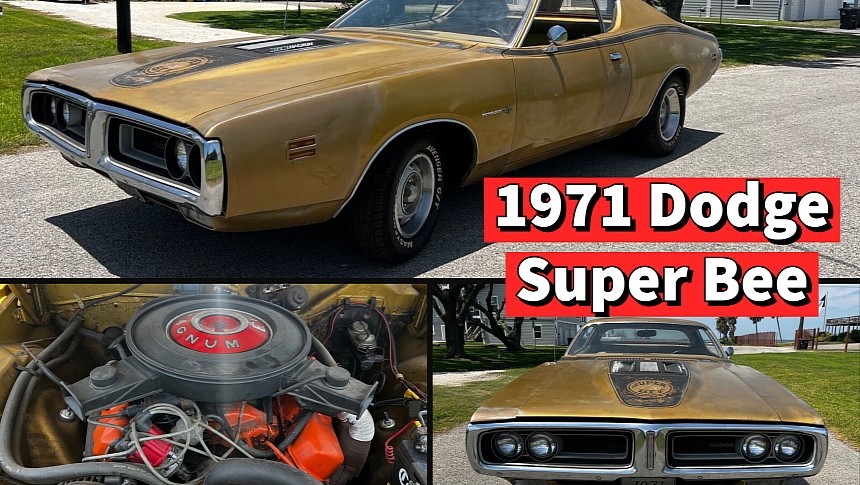Introduced in 1968, the Dodge Super Bee was the company's low-priced muscle car. The brand's alternative to the Plymouth Road Runner, the Super Bee was based on the Coronet from 1968 to 1970. In 1971, its final year on the market, the affordable muscle car was moved to the platform used by the Dodge Charger.
The Super Bee had a slow start in 1968, moving only 7,842 units, but sales climbed to an impressive 27,800 examples in 1969. Following a successful 1970 model year with 15,506 deliveries, the Super Bee found only 5,054 customers in 1971. While not the most desirable iteration of the nameplate, the 1971 Super Bee is arguably the rarest as far as production numbers go.
Built in only 22 units, the HEMI is obviously the scarcest. The 440-cubic-inch (7.2-liter) V8 cars are also hard to find though. Dodge sold only 26 equipped with the four-barrel version, while only 99 customers opted for the "Six-Pack" variant. The newly introduced 340-cubic-inch (5.6-liter) V8, also the smallest engine ever offered in the Super Bee, wasn't exactly popular either at 307 examples made.
Finally, Dodge produced 3,858 Super Bee equipped with the 383-cubic-inch (6.3-liter) Magnum big-block. The automatic version was by far the most popular, selected by 2,889 customers. That's more than half of the total Super Bee production for 1971. The three-speed was the least desirable transmission, with the 383 at 203 units. This leaves us with 766 cars fitted with the 383 and the four-manual gearbox.
While not as rare as the HEMI, these 383/4-speed rigs, often described as perfect for the three-pedal enthusiast, are also hard to find in running condition. Add the unrestored and unmolested factors into the mix, and you pretty much need to chase one of only a few dozen cars still out there. The GY8 gold example you see here is one of them. If you've been looking for one, this Super Bee awaits a new owner in Dickinson, Texas.
And not only is it an unrestored survivor that still runs and drives, but it also presents itself in excellent condition for a classic that has soldiered on without a refresh for more than 50 years. Sure, the gold paint is rough in some places, and I spotted a rust hole in the lower corner of the rear window, but hey, you'd be hard-pressed to find a 1971 survivor in better condition.
Making things even better, the 335-horsepower V8 and the four-speed manual are of the numbers-matching variety. Both operate as they should, and the powerplant looks very clean. But perhaps that's not surprising given that the odometer shows only 80,501 miles (129,554 km), which further suggests the muscle car spent much of its 52 years (as of 2023) in storage.
Although it's unrestored on the outside, the Super Bee got a refresh inside the cabin, sporting refurbished seat covers. The owner also rebuilt the Holley four-barrel carburetor and replaced the fuel tank. So how much to take this Mopar home? The car is listed for $28,000 with no option to make a lower offer. For reference, 1971 Super Bee values vary from $29,300 for vehicles in Fair condition to $82,700 for Concours-ready examples.
Built in only 22 units, the HEMI is obviously the scarcest. The 440-cubic-inch (7.2-liter) V8 cars are also hard to find though. Dodge sold only 26 equipped with the four-barrel version, while only 99 customers opted for the "Six-Pack" variant. The newly introduced 340-cubic-inch (5.6-liter) V8, also the smallest engine ever offered in the Super Bee, wasn't exactly popular either at 307 examples made.
Finally, Dodge produced 3,858 Super Bee equipped with the 383-cubic-inch (6.3-liter) Magnum big-block. The automatic version was by far the most popular, selected by 2,889 customers. That's more than half of the total Super Bee production for 1971. The three-speed was the least desirable transmission, with the 383 at 203 units. This leaves us with 766 cars fitted with the 383 and the four-manual gearbox.
While not as rare as the HEMI, these 383/4-speed rigs, often described as perfect for the three-pedal enthusiast, are also hard to find in running condition. Add the unrestored and unmolested factors into the mix, and you pretty much need to chase one of only a few dozen cars still out there. The GY8 gold example you see here is one of them. If you've been looking for one, this Super Bee awaits a new owner in Dickinson, Texas.
And not only is it an unrestored survivor that still runs and drives, but it also presents itself in excellent condition for a classic that has soldiered on without a refresh for more than 50 years. Sure, the gold paint is rough in some places, and I spotted a rust hole in the lower corner of the rear window, but hey, you'd be hard-pressed to find a 1971 survivor in better condition.
Making things even better, the 335-horsepower V8 and the four-speed manual are of the numbers-matching variety. Both operate as they should, and the powerplant looks very clean. But perhaps that's not surprising given that the odometer shows only 80,501 miles (129,554 km), which further suggests the muscle car spent much of its 52 years (as of 2023) in storage.
Although it's unrestored on the outside, the Super Bee got a refresh inside the cabin, sporting refurbished seat covers. The owner also rebuilt the Holley four-barrel carburetor and replaced the fuel tank. So how much to take this Mopar home? The car is listed for $28,000 with no option to make a lower offer. For reference, 1971 Super Bee values vary from $29,300 for vehicles in Fair condition to $82,700 for Concours-ready examples.




















